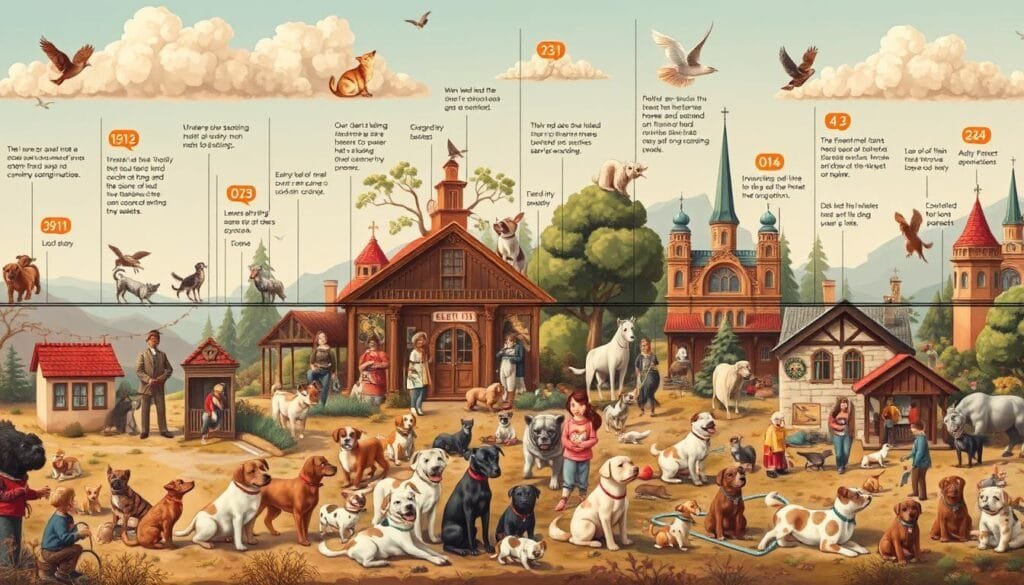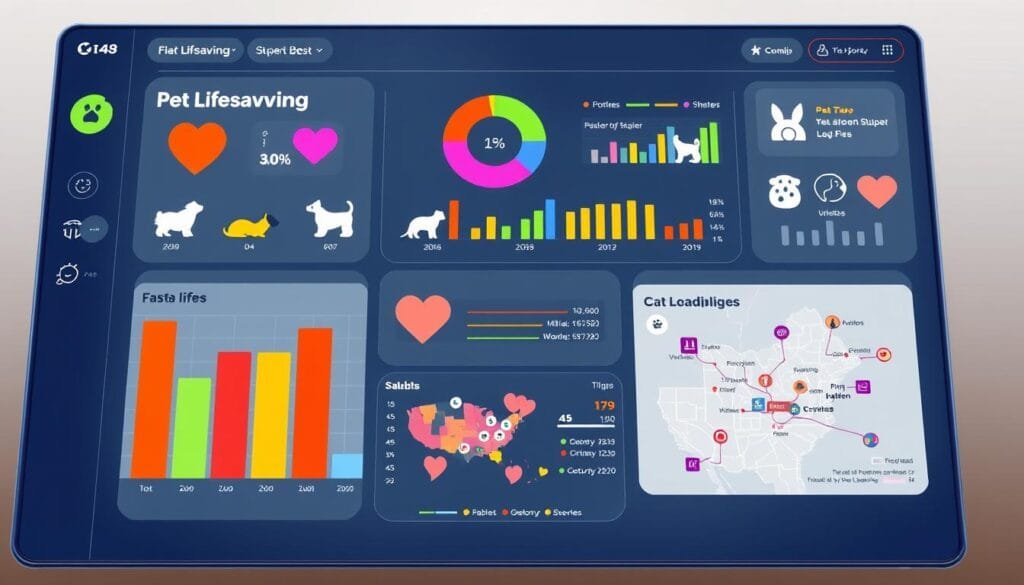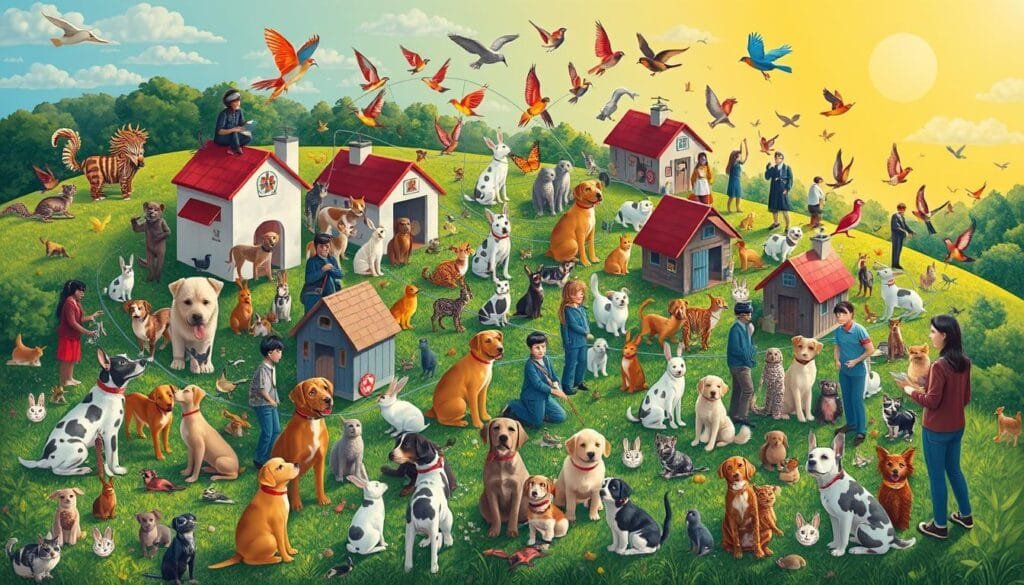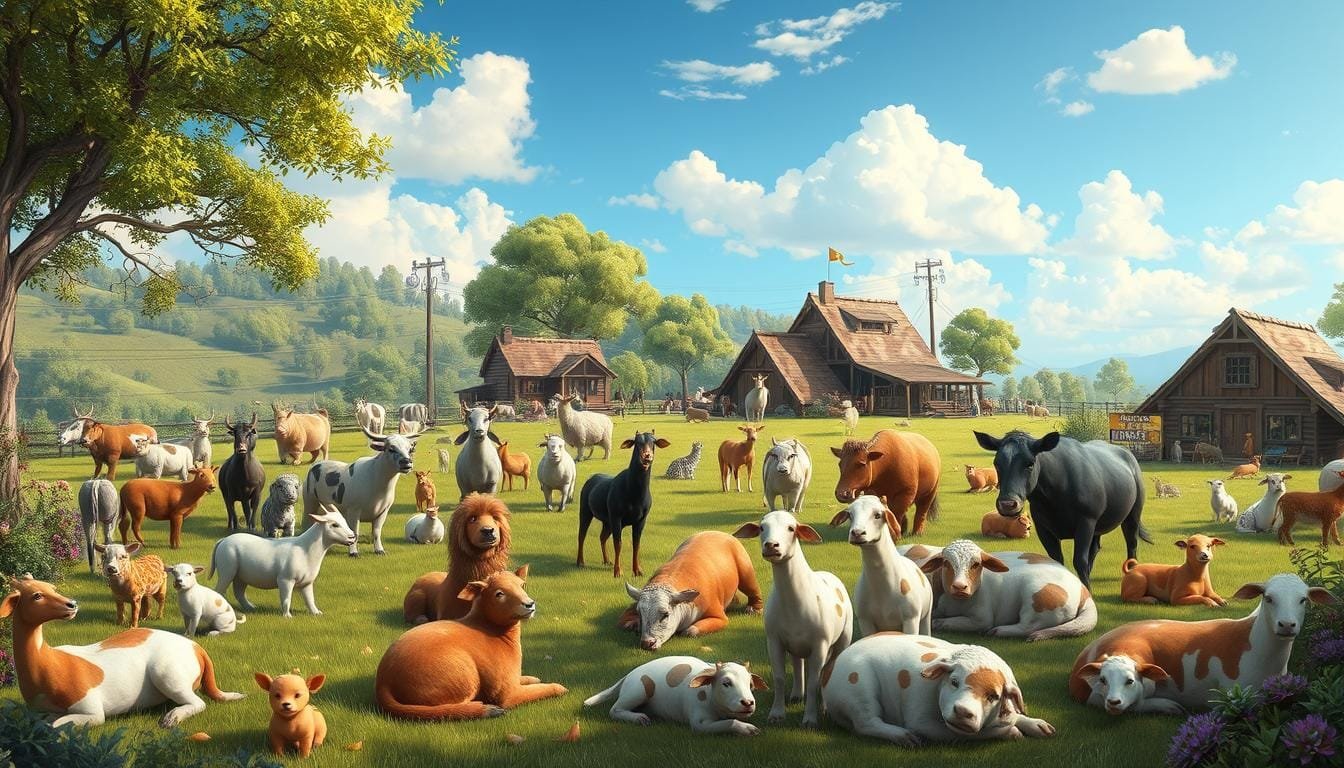In 1984, a change in animal welfare in the U.S. was much needed. That year, around 17 million dogs and cats were being put to sleep in shelters every year. A group of people dedicated to making a difference started Best Friends Animal Society.
They had a big goal: to stop animals from being euthanized in shelters. To make this happen, they gathered detailed data, came up with new ways to help, and worked closely with communities.
Key Takeaways
- Best Friends Animal Society was established in 1984.
- Approximately 17 million dogs and cats were euthanized annually in U.S. shelters at the time.
- The organization was founded to transform animal welfare practices.
- Best Friends aimed to build a no-kill nation.
- Community-focused initiatives were central to their strategy.
The Origins of Best Friends Animal Society
Best Friends Animal Society started in a surprising place – the Process Church of the Final Judgment. This group, created by Robert Grimston and Marianne McLean in the 1960s, changed a lot over time. It became a leading animal welfare organization.
Foundation Years
The Process Church was first known for its different religious practices. It was famous for its unique beliefs and ties with well-known criminals. However, these early years helped build a united community. This community later focused on animal welfare.
Transformation from the Process Church
The move from the Process Church to Best Friends Animal Society was a notable change. In the 1970s, the founders redirected their efforts to animal care. They established a sanctuary in Kanab, Utah. This place became the core of Best Friends Animal Society. It was a big step in changing the group’s image.
Early Controversies and Criticism
The early days of Best Friends faced challenges. Their start in the Process Church led to doubts and criticism. Despite a rough start, their dedication to animals built their reputation. The Kanab sanctuary showed their commitment, earning them wider support.
People have advanced by learning from each other, leading to the growth of complex societies. This idea mirrors the story of Best Friends Animal Society. Cultural changes encouraged competition, pushing groups to adopt better strategies. To learn more about this, check out the study on cultural adaptation and cooperation here.
Evolution of Animal Welfare Efforts
Animal welfare has always been key to our mission at Best Friends Animal Society. Our commitment has led to significant advances in animal lives. We’ve focused on data-driven strategies to make every action count.

We found that data on shelter animals was lacking so we started a nation-wide data collection. This effort helps us create targeted programs. These programs work to lower euthanasia rates and support the no-kill movement in the U.S.
In places like China, discussions on animal rights have become more common. Incidents of wildlife attacks and deaths in shows have raised awareness. These issues, highlighted by scholars like Professor Qiu Renzhong, have pushed for policy and attitude changes towards animals.
A survey in China showed different views on farm animal welfare. People’s opinions were influenced by their age, education, and where they lived. Many wanted laws for better animal welfare, showing concern for food safety and health. But, a lot of them didn’t know much about how farm animals are treated.
| Factor | Influence on Attitudes |
|---|---|
| Gender | Significant |
| Age | Notable |
| Education | High |
| Income | Moderate |
| Urban vs. Rural Residence | Distinct |
The advancements by *Best Friends* show how data and activism can create a kinder society. This approach, used in China too, promises better days ahead for animal welfare everywhere.
Key Milestones in Our Journey
Since we started, making sure no animal is unnecessarily euthanized has been our core mission. Best Friends Animal Society kicked off this huge change. We’ve taught the public and leaders about it, cutting down the number of animals euthanized nationwide much.
Introduction of the No-Kill Movement
The No-Kill Movement was a big change in how we care for animals. It pushed shelters everywhere to stop euthanizing animals. Because of it, more animals are saved and get to find families who love them.
Innovative Programs and Initiatives
We didn’t stop there. We rolled out new projects to help shelter animals even more. A cool project we started is the Pet Lifesaving Dashboard. It helps shelters use data to get better, save more animals, and follow the best ways to care for them.
| Year | Milestone |
|---|---|
| 1984 | Founding of Best Friends Animal Society |
| 1990s | Introduction of the No-Kill Movement |
| 2000s | Establishment of nationwide animal welfare programs |
| 2016 | Launch of the Pet Lifesaving Dashboard |
| 2018 | Opening of new regional lifesaving centers |
Impact on Animal Sheltering Practices
Best Friends Animal Society has truly changed how shelters work across the U.S. They introduced the Pet Lifesaving Dashboard, a tool that helps shelters operate better. This reduces the need to euthanize animals. The dashboard lets shelters see what’s going on, helps in making good decisions, and addresses needs fast.
By using this detailed data, shelters can see where they’re doing well and where they need to do better. It helps them save more animals’ lives.
The Pet Lifesaving Dashboard

This tool updates in real-time and has interactive features. It makes shelters’ work more open and accountable. It shows detailed information on how many animals come in and go out. This helps shelters plan how to save more lives.
The dashboard helps use information to make smart choices, lowering euthanasia rates. It makes it possible for everyone to see and celebrate saving more animals.
Shelter Collaborative Programs
Our strategy includes a strong focus on working together with other shelters. Our Shelter Collaborative Programs connect shelters all over, sharing resources and advice. These programs help them share what works and what doesn’t and achieve more together.
By working in unity, we have already seen many success stories. This proves that collaboration can lead to great outcomes in saving animal lives.
The Rise of the Best Friends Network
The Best Friends Network shows how well communities can work together for animal welfare. It has over 5,000 member groups. They share resources, knowledge, and support with each other all over the nation.

Our animal welfare network boosts the work of local groups by bringing them together. It connects shelters, rescue groups, and others. This way, they can help more animals together. By building a strong shelter support community, no one has to tackle problems alone.
Here is a quick look at how the Best Friends Network has grown:
| Year | Number of Member Groups | Key Milestone |
|---|---|---|
| 2000 | 300 | Initial Expansion |
| 2010 | 2,000 | Major Collaboration Initiatives |
| 2020 | 5,000+ | Enhanced National Support |
With our combined effort in the Best Friends Network, animal welfare has improved a lot. We’ve increased the number of no-kill communities. By keeping the network strong and supportive, we’re making a big difference in animal welfare.
A Test Dominated Society China: Lessons from Our Data-Driven Approach
In our quest for improved data-driven animal welfare, we look to China’s success with data. They use data in governance and business, offering lessons for our animal welfare technology.
Data Collection Methods
Our approach to collecting data is detailed and draws from techniques seen in China. Here’s what we do:
- Internet research to gather public data
- FOIA requests to acquire specific governmental information
- Collaborative data-sharing initiatives such as the Shelter Pet Data Alliance
Our methods lay the groundwork for informed animal welfare decisions. We aim to bring all data under one roof, just like China’s approach.
Real-Time Data Project
The Real-Time Data Project is changing animal welfare technology. It gives shelters up-to-the-minute data. This helps them make faster, smarter choices.
Access to data in real-time means we can improve animal welfare quickly. This strategy is inspired by China’s use of data in business and governance. It shows the good and the complex sides of using real-time data.
With thorough data collection and real-time updates, we’re leading in animal welfare. Our goal is to set new benchmarks by being effective and adaptable.
Challenges and Criticisms Faced
Best Friends Animal Society has seen lots of success. But, it has also faced challenges and criticisms. The group’s beginnings and early actions drew attention. This has had a big impact on how people see us and our work.
Our challenges are varied, mixing past and present issues. We’ve been criticized from many sides. Talks often focus on animal welfare issues. This leads to calls for us to do better and be more open.
Questions about how we handle money and achieve our goals are common too. This makes us work harder to show we’re doing the right things. We want our actions to match our mission and what people expect from us in animal welfare.
We know we have to do real work to address these challenges. We aim to be clear about what we do and always get better. Reviewing and improving our policies is a big part of earning trust and support.
Our efforts to fix animal welfare problems look towards both the present and the future. This has led us to create new programs. These programs take into account feedback from both inside and outside the group.
We see these challenges as chances to learn and help other groups learn too. The road is long, but we’re committed to making things better for animals every step of the way.
| Challenges | Impact | Response |
|---|---|---|
| Scrutiny over origins | Public distrust | Enhanced Transparency |
| Nonprofit Criticisms | Funding Management | Policy Updates |
| Animal Welfare Controversies | Operational Standards | Program Improvements |
Future of Animal Sheltering: The Pet Resource Center
The Future of animal sheltering focuses on creative designs and putting the community first. The Pet Resource Center shows off this new way of thinking. It combines the latest building designs with a focus on bonds between people and pets. We’re all about using community ideas in every step of this project.
Inception and Design
The Pet Resource Center began with a goal to change old shelters into community-driven sheltering spaces. This place gives importance to open areas, sunlight, and spaces where pets and people can meet. It’s all about making animals happier and welcoming visitors.
Impact on Modern Sheltering
The Pet Resource Center is changing sheltering today more than just its looks. We’re working on setting a new benchmark for shelters everywhere. Our centers serve as both a cozy place for pets and a hub for community services. They offer education, vet care, and adoption all in one. This whole approach looks after both animals and their soon-to-be owners.
Community Engagement
At the heart of the Pet Resource Center is connecting with the community. Through events, workshops, and outreach, we support community-driven sheltering. These efforts help nurture responsible pet care and strengthen the human-animal bond. By giving the community the tools and knowledge they need, we can help more animals find homes.
Conclusion
Best Friends Animal Society has been a pioneer in animal welfare. We have established a strong foundation over the years. This includes our role in the No-Kill Movement and starting new programs that have changed sheltering across the country. These efforts are well-documented in a summary of Best Friends achievements.
Our work led to the creation of tools like the Pet Lifesaving Dashboard and Shelter Collaborative Programs. These tools have been key in pursuing our goals. The future of Best Friends is filled with continued commitment. We will keep developing our strategies and working closely with communities to stay at the leading edge of animal advocacy. Our focus on data helps keep us leading the charge.
Despite many hurdles, we keep pushing forward toward a no-kill nation. We adapt and innovate in response to the changing world of animal welfare. Best Friends Animal Society remains fiercely dedicated to our cause. Through our efforts now and in the future, we’re working toward a kind, no-kill world. This aligns with our goal of continuing animal advocacy. We’re always striving to do more for animal welfare.
FAQ
When was Best Friends Animal Society established?
Best Friends Animal Society started in 1984. They wanted to change how animals were treated.
What prompted the foundation of Best Friends Animal Society?
The society began to fight a sad truth. About 17 million dogs and cats were euthanized in US shelters every year.
How did Best Friends Animal Society originate?
It came from a spiritual group named the Process Church of the Final Judgment. Robert Grimston and Marianne McLean founded it in the 1960s.
What is the No-Kill Movement?
The No-Kill Movement aims to stop euthanasia in shelters. Best Friends Animal Society led this change.
What significant programs have Best Friends Animal Society implemented?
They started key programs like the Pet Lifesaving Dashboard and Shelter Collaborative Programs. These initiatives make shelters better and the lives of animals more joyful.
What is the Best Friends Network?
Over 5,000 groups form the Best Friends Network. This network shares resources and support, helping animals all over the country.
How does Best Friends Animal Society use data in their approach?
They focus on gathering detailed data. They use internet research, FOIA requests, and partnerships for their projects.
What challenges has Best Friends Animal Society faced?
They’ve dealt with doubts about their past and their actions. This pushed them to always be open and keep improving their methods.
What is the Best Friends Pet Resource Center?
This Center is reimagining animal sheltering. It creates welcoming spaces for people and pets and supports responsible pet ownership.
